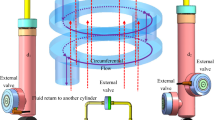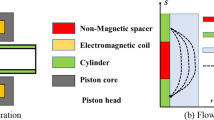Abstract
A hybrid type magneto-rheological (MR) fluid damper based on electromagnet and two permanent magnets apart from electromagnet was designed and its characteristics were analyzed numerically. In the proposed MR damper, the magnetic field is generated by the permanent magnet and raised by the additional electromagnet. This combination provides a larger amount of damping force with lower consumption of electric energy. The proposed model has an additional advantage of providing a moderate damping force in case of electromagnet failure. The magnetic circuit of a hybrid MR valve was analyzed by applying Kirchhoff’s law and magnetic flux conservation rule. A 2D axisymmetric model of the proposed hybrid MR damper was developed in commercial software where magnetic field properties are analyzed by finite element method. The optimization process was developed to optimize the geometric parameters and generated damping force using design of experiment (DoE) technique. The damping force of the MR damper was selected as an objective function. The optimal solution to the optimization problem of the hybrid MR valve structure was evaluated and compared with the solution obtained from the initial parameters. It is demonstrated that the novel hybrid type provides higher damping force than the previous model.
Similar content being viewed by others
References
A. Spaggiari, Properties and applications of magnetorheological fluids, Fracture and Structural Integrity, 7(23) (2012) 48–61.
S. E. Premalatha, R. Chokkalingam and M. Mahendran, Magneto mechanical properties of iron-based MR fluids, American J. of Polymer Science, 2(4) (2012) 50–55.
S. K. Mangal and A. Kumar, Experimental and numerical studies of magnetorheological (MR) damper, Chinese J. of Engineering, 2014 (2014) 1–7.
G. Z. Yao, F. F. Yap, G. Chen, W. H. Li and S. H. Yeo, MR damper and its application for semi-active control of vehicle suspension system, Mechatronics, 12(7) (2002) 963–973.
J. W. Sohn, J. S. Oh and S. B. Choi, Design and novel type of a magnetorheological damper featuring piston bypass hole, Smart Materials and Structures, 24(3) (2015) 035–013.
H. Sahin, Y. Liu, X. Wang, F. Gordaninejad, C. Evrensel and A. Fuchs, Full-scare magnetorheological fluid dampers for heavy vehicle rollover, J. of Intelligent Material Systems and Structures, 18(12) (2007) 1161–1167.
Z. C. Li and J. Wang, A gun recoil system employing a magnetorheological fluid damper, Smart Materials and Structures, 21(10) (2012) 105003.
A. Ulasyar and I. Lazoglu, Design and analysis of a new magneto rheological damper for washing machine, Journal of Mechanical Science and Technology, 32(4) (2018) 1549–1561.
Q.-H. Nguyen, S. Choi and J. Woo, Optimal design of magnetorheological fluid-based dampers for front-loaded washing machines, Proceedings of the Institution of Mechanical Engineers, Part C: J. of Mechanical Engineering Science, 228(2) (2014) 294–306.
C. Seid, S. Sujatha and S. Sujatha, Optimal design of an MR damper valve for prosthetic knee application, Journal of Mechanical Science and Technology, 32(6) (2018) 2959–2965.
T.-H. Lee, C. Han and S.-B. Choi, Design and damping force characterization of a new magnetorheological damper activated by permanent magnet flux dispersion, Smart Materials and Structures, 27 (1) 015013.
G. Hu, Y. Lu, S. Sun and W. Li, Development of a self-sensing magnetorheological damper with magnets in-line coil mechanism, Sensors and Actuators A; physical, 255 (2017) 71–78.
P. Xiao, H. Gao and L. Niu, Research on magnetorheological damper suspension with permanent magnet and magnetic valve based on developed FOA-optimal control algorithm, Journal of Mechanical Science and Technology, 31(7) (2017) 3109–3119.
X. Bai and N. M. Wereley, A fail-safe magnetorheological energy absorber for shock and vibration isolation, J. of Applied Physics, 115 (17) 17B535.
G. Wulff, A. Thoma, G. Reusing, St. Irmscher and W. Herdeg, Vibration damper, in particular for motor vehicles, US Patent US5632361A (1997).
H. Boese and J. Ehrlich, Performance of magnetorheological fluids in a novel damper with excellent fail-safe behavior, J. of Intelligent Material Systems and Structures, 21(15) (2010) 1537–1542.
Q.-H. Nguyen and S.-B. Choi, Optimal design of MR shock absorber and application to vehicle suspension, Smart Materials and Structures, 18(3) (2009) 035012.
S.-J. Moon, Y.-C. Huh, H.-J. Jung, D.-D. Jang and H.-J. Lee, Sub-optimal design procedure of valve-mode magnetorheological fluid dampers for structural control, KSCE J. of Civil Engineering, 15(5) (2011) 867–873.
T. Avraam, MR-fluid Brake Design and its Application to a Portable Muscular Rehabilitation Device, Université Libre de Bruxelles (2009).
J. Zheng, Z. Li, J. Koo and J. Wang, Magnetic circuit sesign and multiphysics analysis of a novel MR damper for applications under high velocity, Advances in Mechanical Engineering, 6 (2012) 402501.
S. Purandare, H. Zambare and A. Razban, Analysis of magnetic flux in magneto-rheological damper, J. of Physics Communications, 3(7) (2019) 075012.
W. H. Kim, J. H. Park, S. Kaluvan, Y.-S. Lee and S.-B. Choi, A novel type of tunable magnetorheological dampers operated by permanent magnets, Sensors and Actuators A; physical, 255 (2017) 104–117.
Q.-H. Nguyen, Y.-M. Han, S.-B. Choi and N. M. Wereley, Geometry optimization of MR valves constrained in a specific volume using the finite element method, Smart Materials and Structures, 16(6) (2007) 2242–2252.
G. Peng, Development of MR Fluid Damper for Motorcycle Steering, University of Wollongong, Australia (2011).
A. Hadadian, Optimal Design of Magnetorheological Dampers Constrained in a Specific Volume Using Response Surface method, Concordia University, Canada (2011).
L. Wu, K. Yick, S. Ng and J. Yip, Application of the Box-Behnken design to the optimization of process parameters in foam cup molding, Expert Systems with Applications, 39(9) (2012) 8059–8065.
K. Adinarayana and P. Ellaiah, Response surface optimization of the critical medium components for the production of alkaline protease by a newly isolated Bacillus sp., J. of Pharmacy and Pharmaceutical Sciences, 5(3) (2002) 272–278.
Acknowledgments
This research was supported by Kumoh National Institute of Technology (2016-104-125).
Author information
Authors and Affiliations
Corresponding author
Additional information
Recommended by Editor Seungjae Min
Jung Woo Sohn is an Associate Professor of Mechanical Design Engineering, Kumoh National Institute of Technology, Korea. He received his Ph.D. in Mechanical Engineering from Inha University, Korea. His research interests include smart materials, design and control of smart structures, actuators and sensors for robotics, prognostics, and health management (PHM) and smart system for vehicle applications.
Rights and permissions
About this article
Cite this article
Olivier, M., Sohn, J.W. Design and geometric parameter optimization of hybrid magnetorheological fluid damper. J Mech Sci Technol 34, 2953–2960 (2020). https://doi.org/10.1007/s12206-020-0627-0
Received:
Revised:
Accepted:
Published:
Issue Date:
DOI: https://doi.org/10.1007/s12206-020-0627-0




